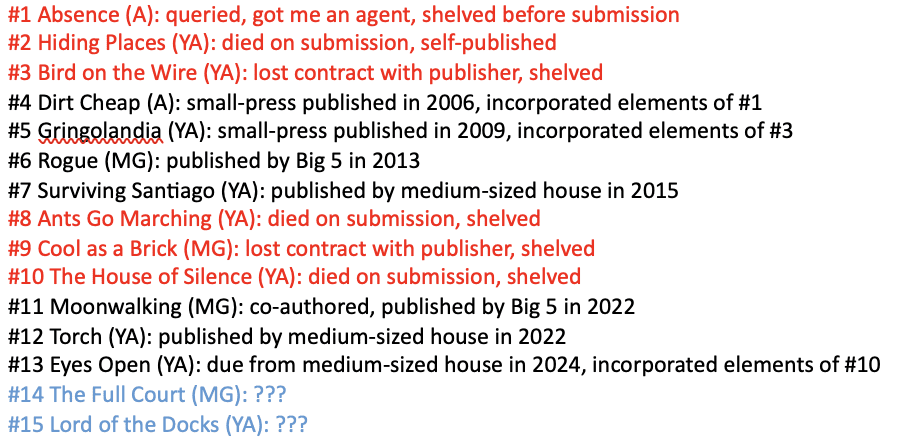My #PublishingJourney
Over the last few weeks many published authors have presented on social media their publishing journeys via a list of manuscripts they have written and the fates of those projects. Most of those journeys are long, with manuscripts never seeing the light of day and years spent writing and revising them. Some authors have talked about stories of their heart that never sold despite their having five other novels published in the meantime. Others had a half dozen or more shelved projects before selling the very first one. Some listed false starts and manuscripts abandoned halfway through, while others had too many of those to mention.
I decided to dive into the fray on Instagram because my journey has been a little different from the others in ways that can be helpful to both beginning writers and those in the middle of their careers. I’ll begin with my list of fiction projects, which I’ve color coded to help viewers see the trajectory. For those unfamiliar with the abbreviations, A is adult, YA is young adult, and MG is middle grade:
My list does not include false starts and abandoned projects because there are far too many of them. It also doesn’t include the large body of nonfiction I’ve written for children, teens, and adults — ranging from reference books for librarians to biographies of Temple Grandin and contemporary women film and TV directors. It also doesn’t include IP projects (books written to fit into publishers’ licensed products), or books published first published in Portuguese that I’ve translated to English.
So what are the takeaways from my experience? The first — illustrated by almost everyone who posted these lists — is that the first finished manuscript is usually a “starter” project that will end up shelved. The great thing about a shelved first novel manuscript is that it’s finished. It has a beginning, middle, and end. It’s proof that the writer can complete a manuscript. All these starter projects must be celebrated!
You may have put your heart and soul into this first manuscript. Having to stuff the hard copy in a drawer while the Word or Scrivener file languishes on the computer can be heartbreaking or even a source of shame. You may feel grief at having to let that project go. But don’t despair! It’s not dead. Look at my projects numbered 4, 5, and 13. Each of them incorporated elements from a shelved manuscript. A core plot element in Dirt Cheap incorporated the central plot element of ABSENCE. It just needed to be combined with another plot element to create my eco-thriller for adult readers. Gringolandia had the same plot elements and the same characters (minus one sibling in Daniel’s family) as BIRD ON THE WIRE. But in rewriting the novel from a contemporary to a historical, and changing the point of view from third to first person, I also had the characters do different things. And the ending was completely different. The only chapters that remained the same were the first and part of the sixth. The protagonist of Eyes Open was a secondary character in THE HOUSE OF SILENCE. She does the same thing she did in the earlier manuscript — start a poetry club at her Catholic school where she and her friends write poems to honor her boyfriend, a political prisoner under their dictatorship.
The third takeaway is that it can be just as hard to stay published as to get published for the first time. I had just as many shelved manuscripts in the seven years between 2015 and 2022 as I did in the 10+ years when I was first starting out. It meant that after I thought I’d learned how to write a publishable book, I was not longer writing publishable books. Had I forgotten how to write? Had the competition leapfrogged me? Was my slump an issue of bad luck, a midsized publisher sold to a Big 5 that cleaned house, or bad choices, picking the wrong thing to write? (Given that one of the shelved manuscripts, ANTS GO MARCHING, is all about bad choices, this question seemed particularly pointed.)
But in asking myself these questions, I also made some good choices. I took additional classes and signed up for a mentorship to level up in terms of craft. I tried new ways of telling stories, including the collective protagonist and the verse novel. I connected with my writing community, getting more beta readers and reading their manuscripts in turn. (You often learn as much reading other people’s work as having them read yours.) I left my agent of nine years and looked for one with a more editorial focus, one I knew through my VCFA writing community. I collaborated with better writers and learned from them. And I didn’t quit. Between my third and fourth projects — BIRD ON THE WIRE and Dirt Cheap — ten years passed without my writing any fiction at all. On the other hand, I started THE HOUSE OF SILENCE in 2015, COOL AS A BRICK in 2016, Torch in 2017, Eyes Open in 2018, and Moonwalking in 2019. I basically started one new book a year while continuing to revise the others.
Finally, and in response to a question I received from my Instagram post, I really do think luck and timing play an important part in whether a book of publishable quality actually gets published. The question I received, slightly edited to make my point, was: “Is it common for an agent to sign you…but not try to publish the book?” The questioner was probably referring to ABSENCE and HIDING PLACES — the book that got me my first agent in the 1980s and the book I then wrote for her that she loved but could not sell. The agent took me on because she felt my teenage characters in ABSENCE were more compelling than my adult characters and that, as a high school social studies teacher, I had a gift for portraying an adolescent voice. I decided to write a new YA novel for her rather than turn ABSENCE into a YA novel from just the teenage protagonist’s perspective. But by the time I wrote the new novel — a realistic story about a runaway teen in New York City — trends had changed and publishers wanted light romances, not gritty “problem novels.”
Oh, and these trends do change back. Another reason to hold on to those shelved manuscripts.








